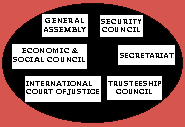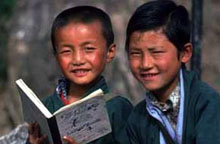What
could the founders of the United Nations do to make sure the new organization wouldn't
suffer the same fate as the League of Nations? In the war-torn world of the 1940's, the impulse to form a cooperative family of
nations emerged stronger than ever.
Even in 1944, a year before the end of the Second World War, the
leaders of four allied nations: the United States, Great Britain,
the Soviet Union and China held a discreet meeting in Washington,
D.C. at an estate called Dumbarton Oaks. Dumbarton Oaks was administered
by Harvard University, which had offered it as a meeting site. Here
they discussed possible plans for an effective cooperative body
of nations. At this meeting and at a broader meeting of world leaders
in San Francisco in 1945, the founders of the United Nations were
determined to create a durable interrelation of parts -- and to strengthen the structural weaknesses that had caused the League of Nations
to disband. The founding member-states decided to make a stronger executive
branch called the Security Council, which would have the authority
to make decisions that member-states would be obliged to act on. Originally, the Security Council was to have 11 members: 5 permanent ones (China, France, Great Britain, the U.S. and the USSR -- the allied powers of the Second World War) and 6 rotating ones that would hold seats for two years. Later, the number of rotating members on the Security Council was increased from 6 to 10 by an amendment of the Charter which came into force in 1965. The Council was to be composed of 15 member-nations,
including 5 permanent members: China, France, Great Britain, the
U.S. and the USSR (the allied powers of the Second World War) and
10 rotating members that would have two-year terms. For a resolution to pass, a total of nine votes would be needed, including votes
(and no vetoes) from permanent members. The decisions of the Security
Council would be binding,
meaning that member-states would be obliged to follow them; nations
that failed to comply were to suffer disciplinary measures such as economic sanctions.
The founders of the United Nations recognized the need for member-states
to commit themselves to backing up words with actions. While the
League of Nations had no military authority, the United Nations
was to have the authority to call on member-states to contribute troops to keep peace in troubled areas. The Security Council would decide the need for military intervention.
All together, there were to be six main branches of the United Nations.
In addition to the Security Council, there was to be the General Assembly, the Economic and Social Council,
the Secretariat, the International Court of Justice,
and the Trusteeship Council.

The General Assembly was to discuss and debate issues of
concern to the world community. Unlike the Security Council, all
nations were to be equally represented in the General Assembly with
each, regardless of its size, having one vote. This means that a
small nation such as Lichtenstein, with a population of under 35,000
was to have the same voting rights as a very large nation such as
India with a population of over a billion. Also, unlike the Security
Council, the General Assembly's decisions would not be binding;
that is, member-states would not be obliged to carry out the decisions
of the General Assembly. General Assembly decisions would, of course,
carry moral authority in the eyes of the world, and in this way, exert pressure on member-states to follow them. Two thirds of the member-states
would have to vote in favor of a resolution in order for it to pass.
The Economic and Social Council was to deal with issues of
economic and social development in different societies. According to the www.un.org web site, “The Economic and Social Council (ECOSOC) serves as the central forum for discussing international economic and social issues, and for formulating policy recommendations addressed to Member States and the United Nations system. It is responsible for:
- promoting higher standards of living, full employment, and economic and social progress;
- identifying solutions to international economic, social and health problems;
- facilitating international cultural and educational cooperation; and
- encouraging universal respect for human rights and fundamental freedoms.
With its broad mandate the Council's purview extends to over 70 per cent of the human and financial resources of the entire UN system.”
The International Court of Justice, located in the Hague,
Netherlands would act as a world court, hearing and settling legal
disputes that member states put before it. The Court was also to
give advisory opinions on legal questions that international organs and agencies
brought to it.
The Trusteeship Council was to protect and advance the interests
of people living in trust territories. But since so many of the
world's trust territories have gained independence, the work
of the Trusteeship Council was formally suspended in 1994.
The Secretariat was to act as the administrative body, serving
the other organs of the United Nations. It would administer the
programmes and policies put in place by the other parts of the Organization.
The representatives of the original 51 member-states in San Francisco
ratified the United Nations Charter on 24 October 1945. Since, then
the date, 24 October has been recognized as "United Nations Day".
And a vision that began as words on pages sprang to life as actions in the world. In the words of the third Secretary-General,
U Thant of Burma (now called Myanmar) "The Charter of the United
Nations is the first, most daring code of behaviour addressed to
the most powerful of all institutions on the planet -- armed nations."
And today, at this writing, it is hard to imagine the world without
the United Nations. As Stephen Schlesinger, author of Act of Creation:
The Founding of the United Nations wrote, "The U.N. and its labors
are, in fact, the background noise of our global age -- sometimes
loud, sometimes soft, but always emitting a hum. One cannot pick
up any major newspaper or watch any network newscast or listen to
any radio news show or consult any media Web site in the United
States and not see or hear the name of the U.N. invoked regularly
by the broadcaster or written down in a daily report by a journalist..."
Click for printable version of this reading passage
Comprehension Check
Vocabulary Puzzle
UN Charter
|






